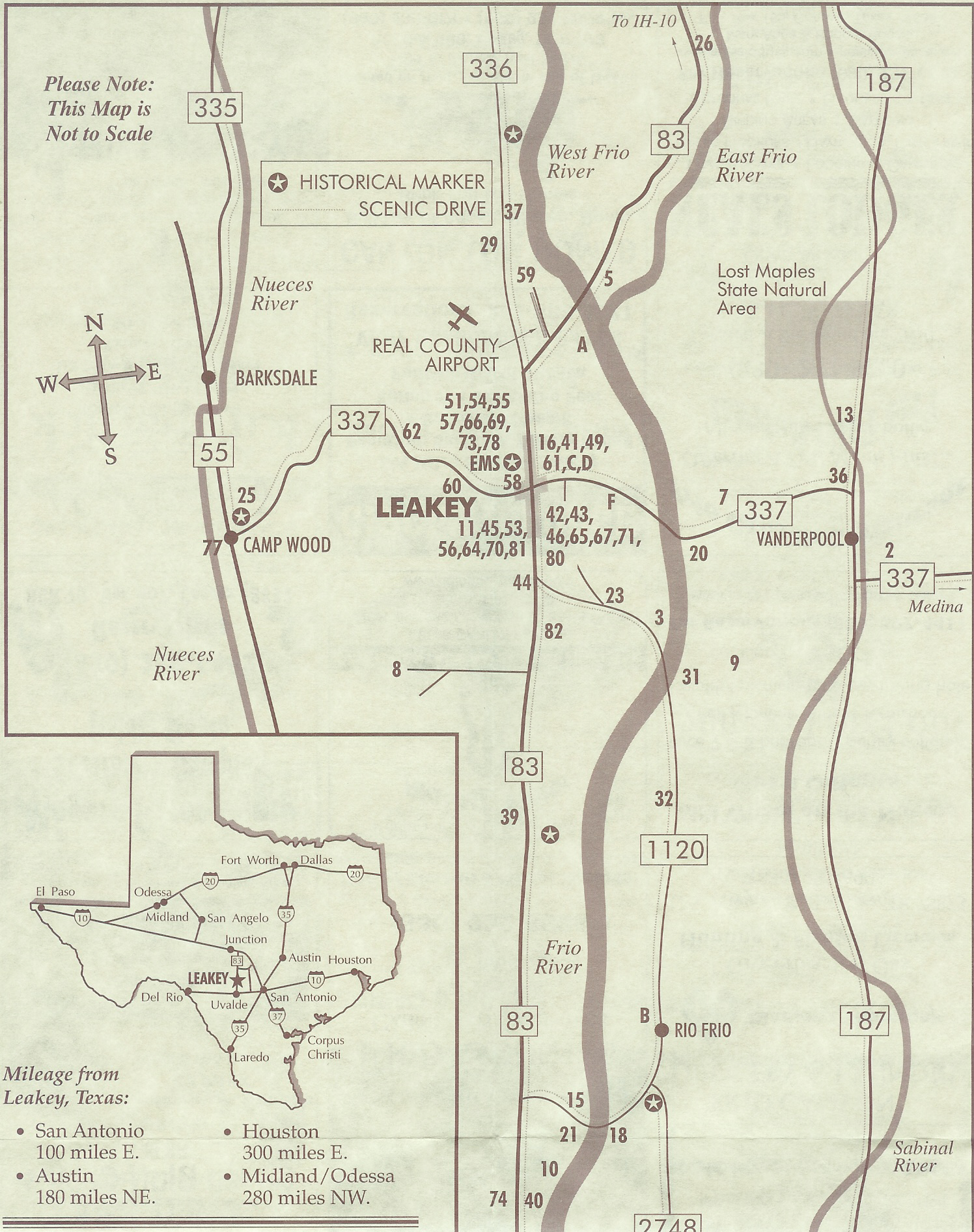| Cynthia Valdez
| Fall, 2005
|
| U.S. History 1302
| R. Hines, Instructor |
More Histories of Small Towns in South Texas
Leakey is a small, peaceful town located about 100 miles northwest of San Antonio in the Texas Hill Country. This small town is located near the Frio River. Like most small towns, Leakey has gone through some important changes. Some of these changes have occurred recently, some changes happened years ago. Through all of these changes, the town of Leakey has maintained its small town appeal. Lipan Apache raids, the Frio River, and Cypress trees all have a role in Leakey’s history.
In 1856 John and Nancy Leakey, along with a few others decided to set up camp and start a shingle business. The town was named after John Leakey in 1883. That year the post office was moved to Leakey from Floral. Floral is what the area was known as before it was named after John Leakey. Edwards County was incorporated the same year.
John and Nancy Leakey had eight children. Mrs. Leakey had her hands full taking care of their children and home. Families at this time had to make their own feather beds, quilts and clothes.
John Leakey came to Texas in 1847. He moved a few times before settling in the Frio Canyon. The Leakey family made their home on the banks of the Frio River. They had fresh water, plenty of wildlife, and the native Cypress and Cedar trees in the area provided lumber to build their homes.
Before the Leakeys settled in the Frio Canyon, Lipans and Comanche inhabited the area. These native people did not give up their land easily. There were often raids and conflicts between the early settlers and the Lipan Apaches and the Comanche.
John Leakey was actively involved in fighting the Indians that were in the Frio Canyon. When the settlers came into the Frio Canyon, Lipan Apache were still frequenting the area. John Leakey was said to have had 13 scars on his body. These scars may have been caused during his many fights with the Indians in Frio Canyon.
Leakey has always been a small town. According to The Handbook of Texas Online, Leakey reached its peak population in 1956 when the population grew to 762. In 1990 there are 399 people living in Leakey. That is down from 1982 when the population was 468
Leakey has an interesting political history. It has been the county seat of two different counties. In 1883, Edwards County was formed. Bullhead was named the county seat. In 1884 the county seat of Edwards County was moved to Leakey. In 1891, amid some controversy, the county seat was moved to Rocksprings.
When Real County was incorporated in 1913, Leakey was named the county seat. Real County was formed from parts of Edwards, Bandera and Kerr counties. This was done because many residents complained of the long trips to the various county seats to take care of county business.
Leakey was not incorporated until 1951, after an election to do so. One of the main reasons for incorporating the city was to get a dependable water source. After incorporation, additional improvements were made. The streets were paved. Street signs were put up, and additional land annexed.*
(*Wagons Ho, A History Of Real County Page 116)
In February of 2005 an important vote took place. It concerned the sale of alcohol in Real County. Leakey had been “dry” since Prohibition days. The subject had been brought up before, but had not been put to the voters since 1913. Supporters of the issue argued the county was losing money to other cities that did sell alcohol. Opponents of the issue worried about the negative effects of alcohol. These include car accidents, and other public safety issues. The election passed with a vote of 198 for and 168 against.
(Uvalde Leader News February 10, 2005)
The main highway through Leakey is Highway 83. This highway runs north to south through the middle of town. Farm Road 337 runs east to west through the middle of town. Most of the original buildings in town are located around the intersection of these two roads.
Leakey is the home of the Real County Historical Museum. The Real Historical Commission runs this museum. The museum has many interesting exhibits. The Alto Frio Baptist Encampment and the HEB Foundation Camp are both located near Leakey. These camps offer a wide variety of activities. The Alto Frio Baptist Encampment is located south of Leakey. The HEB Foundation Camp is located 12 miles north of Leakey.
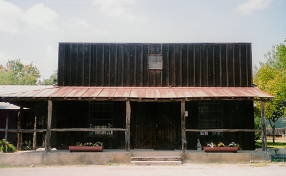 Real County Historical Museum
Real County Historical Museum
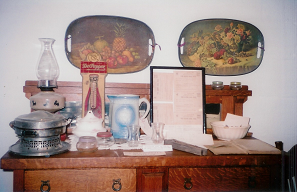
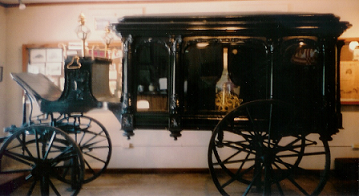
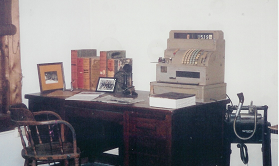
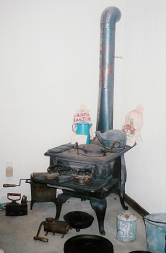
Displays at the Real County Museum
Hunting leases and tourism are growing parts of the economy in Leakey. Hunters are attracted to the hill country by the plentiful wildlife. Tourists are attracted to the town by the river. Tourists have plenty of options. There are many camps located on the riverbanks. Most of these camps are operating year round.
Depending on the season, you can float down the river and swim near your campsite or you can sit back and enjoy the wildlife in the area.
There are also many historical sites to be visited in town.
Shingles and freighting were the basis of Leakey’s economy when the town first started. The shingles were made from the cypress trees in the area. At this time the shingles were made by hand. When the men had a wagon full, the shingles would be taken into the town to sell. This became the freighting part of Leakey’s early economy.
Early in the twentieth century people started raising angora goats for their wool. This was a mainstay in the local economy until about 1910. There are still a few ranches in town raising goats, though not as many as there once were.
Some cattle ranches are still operating in Leakey. As cattle ranches have become less profitable, some ranchers subsidize their income by leasing parts of their ranches to hunters.
When cedar chopping was at its peak most of the choppers were Mexicans. These workers either made their own way up to Leakey or were brought here by ranchers who needed laborers. “So the Texas rancher finally had their own beast of burden which they referred to as ‘Meskins’. Another term of endearment still used frequently is the term ‘wet backs’.’’
-Gueric Bouchard, Wagons Ho, A History of Real County page 127.
Although people needed the cedar choppers, the choppers were thought to be beneath the other residents of Leakey. Cedar chopping was hard work. Choppers were exposed to ticks, snakes, and scorpions. There was no time off for bad weather. Choppers often worked long hours in isolated areas.
The Cedar tree still has a role in Leakey’s economy. Today Cedar Oil is extracted from the trees at the Texarome Plant. Cedar Oil is considered an essential oil. Many perfume manufacturers use this oil.
In the early 1900’s there was a Kaolin mine operating in Leakey. Kaolin is a type of clay used to make ceramics. Many praised the China Kaolin produced. Some of the pieces won prizes at the San Francisco World's Fair in 1915.*
(*Wagons Ho, A History Of Real County Page 83)
The workers at this mine were paid a little more than a dollar a day. When production increased, workers felt they should get a raise. This request was denied and the workers went on strike. Black replacement workers were brought in. The striking workers found the miners’ camp and started firing. The replacement workers opted to leave. The striking workers got their jobs back with increased pay.
Today workers in Leakey are more fortunate. There are still ranches in the area, but the work is different. The ranches are being converted to hunting leases. Some of the land has been transformed into campgrounds. The school district employs many in town. Since Leakey is the county seat of Real County, there are jobs associated with the courthouse.
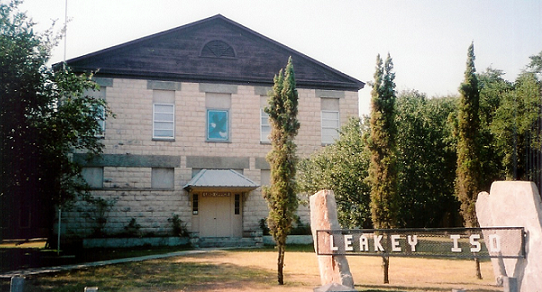
Leakey ISD
When settlers arrived in the Frio Canyon, there was no public school system. Most children were home schooled. The Floral Academy was established in 1882. This school sits on what was called “School House Square”. John & Nancy Leakey donated this land. In 1890 a new school building was completed.
In 1887 the school had 22 students, by 1902 the school had grown to 120 students. These early schools had no indoor plumbing or water. There were two bathrooms out behind the school building one for boys and one for girls. Water was brought in from a neighbors well. Eventually a well was dug near the school. School buildings were added as the school grew.
Leakey ISD was formally established in 1919. Today the school has 248 students. There are grades Pre K-12. All grades are on the same campus. Most grade levels have only one teacher. There are about 22 students per grade level. The campus is located on the site of the original school.
The first school building is still used today.
When I received this assignment, I wasn’t sure what to expect. I hadn’t been to Leakey in a few years. Leakey is still a good place to visit or to stop and take a break in on a trip through the Hill Country. You can have a milkshake at the grocery store. Then you can walk around this peaceful town. Don’t forget the Frio River that helped start this town is just a few blocks away. I enjoyed the opportunity to become reacquainted with this quiet town. I hope to return soon.
Other Leakey Websites:
Texas Handbook Online
Frio Canyon Chamber of Commerce
Leakey,Texas
Return to Small Town Research Projects Index
